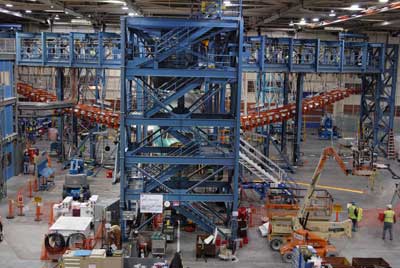SEATTLE, March 19, 2009 -- Boeing [NYSE: BA] last week completed loads calibration testing of the first P-8A Poseidon test aircraft two weeks ahead of schedule. Loads calibration is one of the prerequisites for the U.S. Navy flight clearance process.
During the tests, up to 80 percent of the highest expected flight loads were applied to the aircraft's fuselage, horizontal stabilizers, vertical fin and wing structures. Completion of loads calibration ensures that test aircraft T-1 is ready for airworthiness testing, which will commence later this year.
"One of the reasons we were able to complete the tests ahead of schedule is that the team incorporated some new technologies which enabled us to capture more accurate and more usable data faster," said Mark Magnuson, Boeing P-8A Structural Development and Certification director. "We also completed a number of independent reviews of the test plan prior to the start of testing, in order to reduce risk."
One of the new technologies, optical photogrammetry, entailed installing small video cameras on the P-8A's leading and trailing edges and underneath the fuselage. The measurement system provided three-dimensional, real-time data.
The team now will restore T-1 to its flight configuration and perform additional systems tests prior to first flight.
The P-8A is built by a Boeing-led industry team that includes CFM International, Northrop Grumman, Raytheon, Spirit AeroSystems and GE Aviation. The team currently is assembling and testing the first five P-8As.
The Navy plans to purchase 108 P-8A long-range maritime reconnaissance and anti-submarine warfare aircraft to replace its fleet of P-3Cs. Initial operational capability is slated for 2013.
The Boeing Company, IDS
office: (314) 777-0669
mobile: (314) 705-1661
ellen.j.lemond@boeing.com
The Boeing Company, IDS
office: (253) 657-5636
mobile: (206) 851-4147
charles.b.ramey@boeing.com
The Boeing Company, BCA
office: (425) 269-0822
mobile: (425) 269-0822
daniel.j.ivanis@boeing.com
 USA
USA

